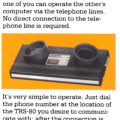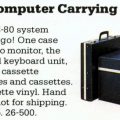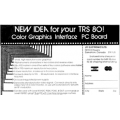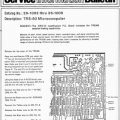The Shuffleboard
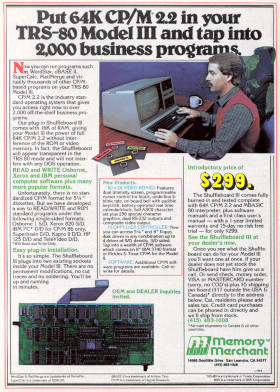
Memory Merchant advertisement for the Shuffleboard III from the November 1983 issue of 80 Micro
Both the Shuffleboard and Shuffleboard III were created by Parasitic Engineering, but the Shuffleboard III achieved most of its popularity after Memory Merchant took over the product.
The Shuffleboard
The original Shuffleboard was actually a companion to another Parasitic Engineering1 product, an 8" drive interface called the Maxi-Disk. Howard Fullmer and Gene Nardi created both the Shuffleboard and Maxi-Disk and introduced them in May 1979 at the Fourth West Coast Computer Faire in Los Angeles, California.
The $995.00 (later $1079.00) Maxi-Disk consisted of two parts:
- an 8" drive that plugged into the Radio Shack Expansion Interface
- a custom circuit board that installed within the Expansion Interface, replacing the normal disk controller chip and allowing 8" drives to work together with 5 1/4" drives
Installation of the Maxi-Disk required no soldering or trace cutting and any existing 5 1/4" drives would continue to work as before. As part of the package, Parasitic Engineering supplied patches to TRSDOS and NEWDOS to allow them to work with the 8" Maxi-Disk drive. However, the Maxi-Disk did not add double-density like the Percom Doubler.
The $249.00 (later $279.00) Shuffleboard worked with (and required) the Maxi-Disk to run CP/M software on the Model I.2 It came with a customized version of CP/M on an 8" disk. Installing the Shuffleboard involved five steps:
- Disassembling the Model I
- Removing the Z80 chip from its socket on the TRS-80 motherboard
- Plugging the Z80 chip into a socket on the Shuffleboard
- Plugging the Shuffleboard into the now empty Z80 socket
- Re-assembling the Model I
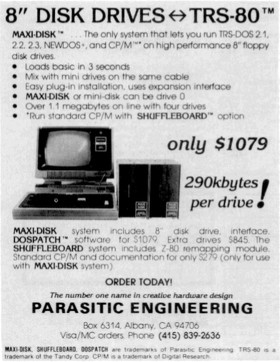
Parasitic Engineering advertisement for the Shuffleboard from the October 1980 issue of 80 Microcomputing
- Mode A always booted a TRSDOS disk. Booting a CP/M disk first required running the TRSDOS command CPM.
- Mode B always booted a CP/M disk. Similar to mode A, booting a TRSDOS disk required running the CP/M command TRSDOS.
At around $1300.00, the Shuffleboard and Maxi-Disk combination was very expensive, but quite an effective way to add CP/M to the Model I. It seems likely that Parasitic Engineering stopped selling the original Shuffleboard in 1982.
The Shuffleboard III
Parasitic Engineering introduced the Shuffleboard III for the Model III in 1981. The initial price seems to have been $495.00. The Shuffleboard III was somewhat simpler than the original Shuffleboard because it didn’t require a separate disk controller like the Maxi-Disk. It could read and write single- and double-density 5 1/4" disks using the Model III’s own disk controller. Unusually, the Shuffleboard III CP/M could not just read and write multiple 5 1/4" CP/M formats3 (Osborne, Xerox, and IBM PC), but it could also format disks in those formats as well.
Installing the Shuffleboard III was only slightly more difficult than the Shuffleboard, with six steps:
- Disassembling the Model III
- Removing the Z80 chip from its socket on the TRS-80 motherboard
- Removing a specific memory chip from the TRS-80 motherboard
- Plugging the Z80 chip into a socket on the Shuffleboard
- Plugging the Shuffleboard into the now empty Z80 socket
- Plugging a connector from the Shuffleboard into the empty memory chip socket
The Shuffleboard III contained 16K of its own memory. This provided a full 64K for CP/M 2.2 when combined with the 48K already installed in a fully-equipped Model III.
Unlike the original Shuffleboard, the Shuffleboard III could automatically detect the type of disk in drive 0 (CP/M or TRSDOS). This avoided the awkwardness of selecting modes through jumpers or switching operating systems using commands. The automatic detection could also be disabled, if desired.
Memory Merchant of San Leandro, California took over sales of the Shuffleboard III sometime in 1982 and set a price of $299.00. According to their advertisements, Memory Merchant offered two other products that worked with the Shuffleboard III:
- An “80 x 24 Video Board” which offered “dual intensity screen, programmable cursor control for block, underline, and blink rate, on board bell with audible keyclick, battery-operated real time calendar/clock, full ASCII character set plus 256 special character graphics, dual RS-232 outputs and composite video output”
- A floppy disk controller to allow an 8" drive to be connected to the Model III (presumably similar to the Maxi-Disk)
Unlike the original Shuffleboard, the $299.00 Shuffleboard III was competitively priced with other Model III CP/M add-ons such as the Omikron Mapper III (at $199.00) and the Holmes VID-80 (at $399.00). Memory Merchant advertised the Shuffleboard III as late as 1984.
-
Even at a time when many microcomputer-related companies had unusual names, Parasitic Engineering was one of the most unusual. Parasitic Engineering co-founder Howard Fullmer once explained that the name was a humorous reference to an editorial that Ed Roberts (then president of MITS) wrote in the MITS company newsletter Computer Notes. In that editorial, Roberts criticized the “parasite companies” that he said were dependent upon MITS for survival. ↩︎
-
Although the Shuffleboard only cost $249.00, requiring the Maxi-Disk made the whole package quite expensive, especially when compared to other CP/M boards such as the Omikron Mapper. On the other hand, having an 8" drive was important because most CP/M software was supplied on 8" disks at the time. ↩︎
-
The 8" CP/M disk format was standardized but the 5 1/4" CP/M disk format never was. There were many incompatible 5 1/4" CP/M disk formats. ↩︎
